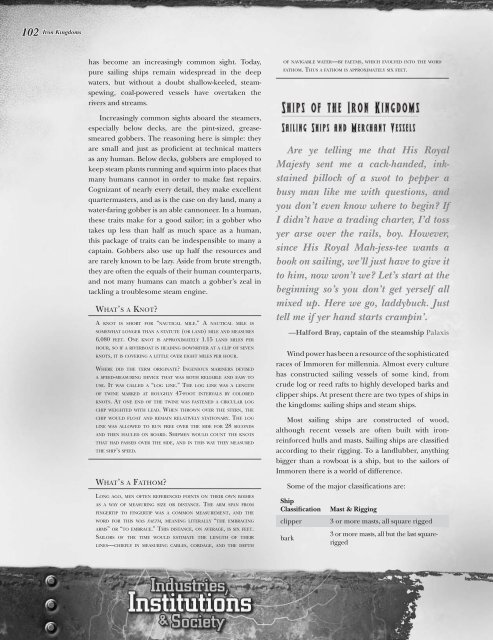02 - Iron Kingdoms W.. - Captain Spud Is Amazing
02 - Iron Kingdoms W.. - Captain Spud Is Amazing
02 - Iron Kingdoms W.. - Captain Spud Is Amazing
Create successful ePaper yourself
Turn your PDF publications into a flip-book with our unique Google optimized e-Paper software.
1<strong>02</strong> <strong>Iron</strong> <strong>Kingdoms</strong><br />
108.1.141.197<br />
has become an increasingly common sight. Today,<br />
pure sailing ships remain widespread in the deep<br />
waters, but without a doubt shallow-keeled, steamspewing,<br />
coal-powered vessels have overtaken the<br />
rivers and streams.<br />
Increasingly common sights aboard the steamers,<br />
especially below decks, are the pint-sized, greasesmeared<br />
gobbers. The reasoning here is simple: they<br />
are small and just as proficient at technical matters<br />
as any human. Below decks, gobbers are employed to<br />
keep steam plants running and squirm into places that<br />
many humans cannot in order to make fast repairs.<br />
Cognizant of nearly every detail, they make excellent<br />
quartermasters, and as is the case on dry land, many a<br />
water-faring gobber is an able cannoneer. In a human,<br />
these traits make for a good sailor; in a gobber who<br />
takes up less than half as much space as a human,<br />
this package of traits can be indespensible to many a<br />
captain. Gobbers also use up half the resources and<br />
are rarely known to be lazy. Aside from brute strength,<br />
they are often the equals of their human counterparts,<br />
and not many humans can match a gobber’s zeal in<br />
tackling a troublesome steam engine.<br />
What’s a knot?<br />
a knot is short for “nautiCal mile.” a nautiCal mile is<br />
someWhat longer than a statute (or land) mile and measures<br />
6,080 feet. one knot is approximately 1.15 land miles per<br />
hour, so if a riverboat is heading doWnriver at a Clip of seven<br />
knots, it is Covering a little over eight miles per hour.<br />
Where did the term originate? ingenious mariners devised<br />
a speed-measuring deviCe that Was both reliable and easy to<br />
use. it Was Called a “log line.” the log line Was a length<br />
of tWine marked at roughly 47-foot intervals by Colored<br />
knots. at one end of the tWine Was fastened a CirCular log<br />
Chip Weighted With lead. When throWn over the stern, the<br />
Chip Would float and remain relatively stationary. the log<br />
line Was alloWed to run free over the side for 28 seConds<br />
and then hauled on board. shipmen Would Count the knots<br />
that had passed over the side, and in this Way they measured<br />
the ship’s speed.<br />
What’s a fathom?<br />
long ago, men often referenCed points on their oWn bodies<br />
as a Way of measuring size or distanCe. the arm span from<br />
fingertip to fingertip Was a Common measurement, and the<br />
Word for this Was faeTm, meaning literally “the embraCing<br />
arms” or “to embraCe.” this distanCe, on average, is six feet.<br />
sailors of the time Would estimate the length of their<br />
lines—Chiefly in measuring Cables, Cordage, and the depth<br />
of navigable Water—by faetms, WhiCh evolved into the Word<br />
fathom. thus a fathom is approximately six feet.<br />
Ships of the <strong>Iron</strong> <strong>Kingdoms</strong><br />
Sailing Ships and Merchant Vessels<br />
Are ye telling me that His Royal<br />
Majesty sent me a cack-handed, inkstained<br />
pillock of a swot to pepper a<br />
busy man like me with questions, and<br />
you don’t even know where to begin? If<br />
I didn’t have a trading charter, I’d toss<br />
yer arse over the rails, boy. However,<br />
since His Royal Mah-jess-tee wants a<br />
book on sailing, we’ll just have to give it<br />
to him, now won’t we? Let’s start at the<br />
beginning so’s you don’t get yerself all<br />
mixed up. Here we go, laddybuck. Just<br />
tell me if yer hand starts crampin’.<br />
Wind power has been a resource of the sophisticated<br />
races of Immoren for millennia. Almost every culture<br />
has constructed sailing vessels of some kind, from<br />
crude log or reed rafts to highly developed barks and<br />
clipper ships. At present there are two types of ships in<br />
the kingdoms: sailing ships and steam ships.<br />
Most sailing ships are constructed of wood,<br />
although recent vessels are often built with ironreinforced<br />
hulls and masts. Sailing ships are classified<br />
according to their rigging. To a landlubber, anything<br />
bigger than a rowboat is a ship, but to the sailors of<br />
Immoren there is a world of difference.<br />
Some of the major classifications are:<br />
Ship<br />
Classification Mast & Rigging<br />
clipper 3 or more masts, all square rigged<br />
bark<br />
—Halford Bray, captain of the steamship Palaxis<br />
3 or more masts, all but the last squarerigged


